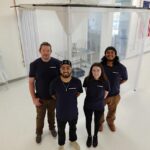
In what can be termed the contract award of the year in the air technology industry, the National Aeronautics and Space Adminstration (NASA) have selected two U.S.based companies, GE Aviation and Magni X, to help it develop propulsion technologies for aircraft, with the mandate of introducing it to the United States aviation fleets by the year 2035.
NASA, an independent agency of the U.S. federal government responsible for the civilian space program, as well as aeronautics and space research has in recent times being aiming to bring to the US air fleets this technological system that uses a powerplant , propellers and the likes to generate flight force.
The two companies are expected to begin and complete operation within the next five years, with part of their work including flight and ground test demonstrations, collaborations with other NASA projects that are focused on electric propulsion, data analysis and flight test instrumentation.
The propulsion technology contract, granted under NASA’s Electric Powertrain Flight Demonstration (EPFD) program is believed to have a combined value of $253.4 million, with $179 million of the total sum awarded to GE Aviation, while MagniX received the remaining $74.3 million.
NASA’s Gaudy Bezos-O’Connor, EPFD project manager while explaining the deal said in a statement:
“GE Aviation and MagniX will perform integrated megawatt-class powertrain system ground and flight demonstrations to validate their concepts, and project benefits for future [electrified aircraft propulsion] aircraft configurations. These demonstrations will identify and retire technical barriers and integration risks. It will also help inform the development of standards and regulations for future EAP systems.”
The EPFD project is a fraction of a wider NASA program known as Integrated Aviation Systems (IAS) that helps conduct research and development with the mandate to infuse next-gen tech into real-world operational flight systems.
There are numerous companies presently working on electric flight propulsion systems but they are mainly found in new air taxi markets that have shorter flights, with the weight of the batteries being limited by the smallish size of the aircraft. Devin Coldewey from TechCrunch had opined that the utmost need to generate lift and weights of the batteries have been the “fundamental conundrum” that has held back electric planes.
It is hoped that these public-private partnership set into motion with this contract will be a final piece of the puzzle as the NASA project will be aiming to develop air technology for short-range and regional air travel, and also a narrow-body, single-aisle aircraft.
Discover more from TechBooky
Subscribe to get the latest posts sent to your email.







